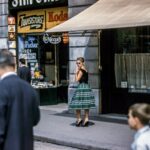The 1920s witnessed a significant transformation in women’s fashion, epitomized by the emergence of the flapper style. This new trend represented a departure from the restrictive Victorian and Edwardian fashions of previous decades. Flapper fashion was characterized by loose, shapeless silhouettes that allowed for greater freedom of movement, abandoning the constrictive corsets and petticoats.
Hemlines rose dramatically, with dresses and skirts reaching above the knee, a stark contrast to the ankle-length garments of earlier eras. This shift in style reflected changing social attitudes and women’s growing assertion of independence. Flapper fashion incorporated bold and daring elements, including more masculine-inspired styles such as tailored suits and trousers.
This marked a significant departure from the ultra-feminine and ornate styles of the past, symbolizing a new sense of empowerment among women. The look was further defined by the use of luxurious fabrics and embellishments, including beading, sequins, and fringe, which added glamour and opulence to the overall aesthetic. The flapper fashion movement represented a radical shift from previous styles and heralded a new era of freedom and self-expression for women in the 1920s.
Key Takeaways
- Flapper fashion emerged as a symbol of women’s liberation and independence in the 1920s, characterized by short skirts, bobbed hair, and a more relaxed silhouette.
- Art Deco influenced fashion with its geometric shapes, bold colors, and luxurious materials, leading to the creation of glamorous and modern clothing and accessories.
- Women’s silhouettes evolved from the restrictive corsets and full skirts of the Victorian era to the straight, boyish shapes of the 1920s, allowing for greater freedom of movement.
- Prohibition led to the rise of speakeasies and underground nightlife, influencing fashion with the popularity of slinky, revealing dresses and accessories like flasks and cigarette holders.
- Hollywood played a significant role in shaping fashion trends by showcasing glamorous and aspirational styles on the silver screen, influencing women’s clothing and accessories.
- Jazz Age menswear saw a shift towards more casual and comfortable clothing for men, with the introduction of sportswear, knitted sweaters, and relaxed suits.
- The legacy of 1920s fashion can be seen in modern design through the continued popularity of flapper-inspired dresses, Art Deco motifs, and the ongoing influence of Hollywood on fashion trends.
The Influence of Art Deco on Fashion
The Aesthetic of Art Deco
Art Deco was characterized by its sleek and geometric aesthetic, with bold lines, symmetrical patterns, and luxurious materials. This design movement had a significant impact on fashion, as designers incorporated Art Deco elements into their clothing and accessories.
Art Deco’s Influence on Fashion
Dresses and gowns featured intricate beading and embroidery inspired by Art Deco motifs, while accessories such as jewelry and handbags showcased geometric shapes and bold, metallic finishes. Art Deco also influenced the color palette of 1920s fashion, with designers favoring bold and vibrant hues such as emerald green, sapphire blue, and ruby red.
A Lasting Legacy
These rich colors added a sense of drama and opulence to the clothing of the era, reflecting the lavish and extravagant spirit of the Art Deco movement. Overall, the influence of Art Deco on fashion during the 1920s was undeniable, as designers embraced the sleek and modern aesthetic of this design movement, creating clothing and accessories that were both elegant and cutting-edge.
The Evolution of Women’s Silhouettes

The 1920s saw a dramatic evolution in women’s silhouettes, as the traditional hourglass figure gave way to a more streamlined and boyish shape. This shift was largely influenced by the flapper fashion movement, which favored loose and unstructured garments that allowed for greater freedom of movement. Dresses and skirts became shorter and straighter, with waistlines dropping to the hips or disappearing altogether.
This new silhouette represented a departure from the tightly cinched waists and full skirts of previous eras, reflecting a more modern and progressive attitude towards women’s fashion. The evolution of women’s silhouettes during the 1920s also reflected changing social attitudes towards women’s roles in society. The streamlined and androgynous look of flapper fashion symbolized a newfound sense of independence and empowerment among women, as they began to challenge traditional gender norms and assert their own identities.
This shift in silhouette also paved the way for greater diversity in women’s fashion, as designers began to experiment with different shapes and proportions, leading to a more inclusive and dynamic approach to clothing design.
The Impact of Prohibition on Fashion
| Impact of Prohibition on Fashion |
|---|
| 1. Rise of Flapper Fashion |
| 2. Shift to more casual and comfortable clothing |
| 3. Increased popularity of evening wear and accessories |
| 4. Emphasis on hidden pockets and secret compartments for carrying alcohol |
| 5. Influence of gangster and speakeasy culture on fashion trends |
The Prohibition era of the 1920s had a significant impact on fashion, as it gave rise to new social settings and activities that influenced clothing trends. With the ban on alcohol leading to the rise of speakeasies and underground nightlife, people began to dress in a more rebellious and daring manner. Women embraced the flapper style with its shorter hemlines, beaded dresses, and bold accessories, reflecting the carefree and hedonistic spirit of the time.
The Prohibition era also saw an increase in illicit activities such as gambling and jazz clubs, which created new opportunities for people to showcase their sense of style in these illicit settings. The impact of Prohibition on fashion was also evident in the rise of menswear-inspired looks for women. With the increased social freedoms brought about by Prohibition, women began to adopt more masculine-inspired styles, such as tailored suits, trousers, and fedoras.
This departure from traditional feminine attire reflected a newfound sense of independence and confidence among women, as they sought to challenge societal norms and express their own individuality through their clothing choices. Overall, Prohibition had a profound impact on fashion during the 1920s, as it gave rise to new social settings and activities that influenced clothing trends and encouraged people to embrace a more rebellious and daring sense of style.
The Role of Hollywood in Shaping Fashion Trends
The 1920s marked the golden age of Hollywood, with the rise of silent films and iconic movie stars who captivated audiences around the world. Hollywood played a significant role in shaping fashion trends during this time, as movie stars became influential style icons whose looks were emulated by fans everywhere. Actresses such as Clara Bow, Louise Brooks, and Greta Garbo set the standard for glamour and sophistication, with their sleek bobbed haircuts, bold makeup, and elegant evening gowns becoming synonymous with 1920s fashion.
Hollywood also played a key role in popularizing certain clothing styles and accessories, as films showcased luxurious costumes and glamorous settings that captured the imagination of audiences. The opulent and extravagant fashions seen on screen inspired designers to create clothing lines that reflected the same sense of drama and allure. Hollywood’s influence on fashion during the 1920s was undeniable, as it brought a sense of fantasy and escapism to people during a time of great social change and upheaval.
The Emergence of Jazz Age Menswear

The Rise of Casual Sportswear
The Jazz Age also witnessed an increase in casual sportswear for men, with items such as polo shirts, knickerbockers, and spectator shoes becoming popular choices for leisure activities like golfing or tennis. This shift towards more relaxed and informal clothing reflected a newfound sense of freedom and leisure among men, as they sought to embrace a more carefree and adventurous lifestyle.
A Departure from Traditional Sartorial Norms
The emergence of Jazz Age menswear represented a significant departure from traditional sartorial norms, as men began to embrace more casual and comfortable styles that reflected the changing social attitudes of the time. This new approach to fashion allowed men to express their individuality and showcase their personal style.
A New Era of Menswear
Overall, the 1920s marked a significant turning point in menswear fashion, as men began to prioritize comfort, practicality, and self-expression in their clothing choices. This new era of menswear paved the way for future generations to experiment with fashion and push the boundaries of traditional style.
The Legacy of 1920s Fashion in Modern Design
The influence of 1920s fashion can still be seen in modern design, as designers continue to draw inspiration from the iconic styles of this era. The streamlined silhouettes, bold colors, and luxurious embellishments that defined 1920s fashion have become timeless elements that continue to resonate with contemporary audiences. Designers often incorporate Art Deco motifs into their collections, creating clothing and accessories that pay homage to the sleek and geometric aesthetic of this design movement.
The legacy of 1920s fashion can also be seen in the ongoing popularity of flapper-inspired looks, with designers creating modern interpretations of the iconic style that capture its rebellious spirit and sense of glamour. The influence of Hollywood on fashion also continues to be felt today, as celebrities and movie stars remain influential style icons whose looks are emulated by fans around the world. Overall, the legacy of 1920s fashion in modern design is undeniable, as its enduring influence continues to inspire designers to create clothing that reflects the same sense of elegance, sophistication, and individuality that defined this iconic era.
If you’re interested in learning more about the fashion era, you should check out this article on extraquirky.com. They have a great selection of articles that dive into the history and evolution of fashion, offering a unique perspective on how different eras have influenced the way we dress and express ourselves. Whether you’re a fashion enthusiast or just curious about the impact of fashion on culture, you’ll find plenty of interesting insights on their website.
FAQs
What is the fashion era?
The fashion era refers to a specific period of time in history that is characterized by distinct styles, trends, and influences in clothing and accessories.
What are some examples of fashion eras?
Some examples of fashion eras include the Victorian era, the Roaring Twenties, the Swinging Sixties, and the grunge fashion of the 1990s.
How do fashion eras influence current trends?
Fashion eras often influence current trends through revivals and reinterpretations of past styles. Designers and brands often draw inspiration from historical fashion eras to create modern looks.
What are some key characteristics of fashion eras?
Key characteristics of fashion eras include specific silhouettes, fabrics, colors, and accessories that were popular during that time period. These elements help define the overall aesthetic of the era.
How do fashion eras reflect the culture and society of their time?
Fashion eras often reflect the culture and society of their time by showcasing the values, attitudes, and social changes that were prevalent during that period. Clothing and fashion choices can be a reflection of the larger cultural context.









